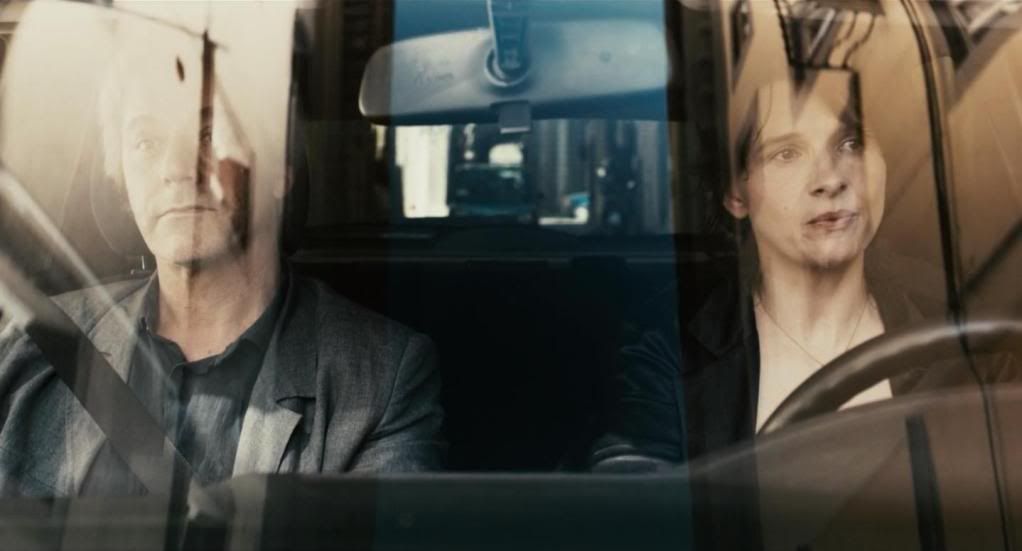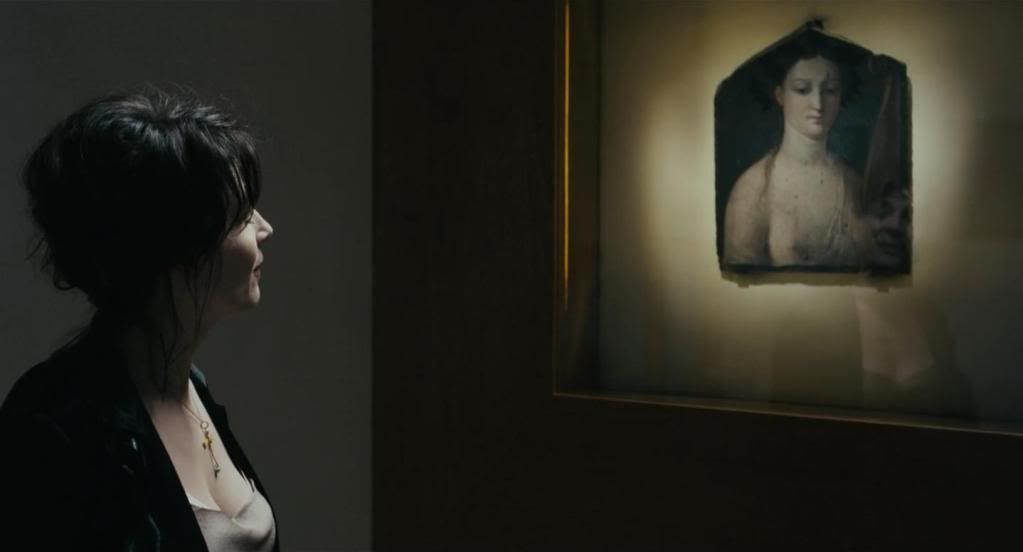
There is a small, unobtrusive scene in Abbas Kiarostami's Certified Copy that provides a neat synecdoche for this puzzling, ambiguous, enthralling film. The writer James (William Shimell) is standing in an Italian plaza, watching an older French couple who seem to be arguing, the man yelling at the woman, who just stands there taking his abuse. Kiarostami shoots the scene from James' perspective, with the man facing away from him. From James' point of view, the woman is mostly obscured by the man's back, but when the man turns to present his profile to James instead, the scene changes, and it turns out that he's actually yelling into a phone, that he's not even angry, really, but is yelling to make himself heard over a noisy connection. From one perspective, the scene looks like one thing, but with nothing but a 90-degree turn, what had seemed like marital discord is transformed into a simple phone conversation. It's a very modern kind of joke — a public altercation between spouses becomes "can you hear me now?" — but it's also a wonderful encapsulation of the themes lurking at the core of this very slippery film.
This is not the film's only unhappy marriage that might not be what it seems. Certified Copy — the film, that is; it's also the title of James' book, an essay about how copies are as valid and important as originals — takes the form of a meeting between James and a woman, sometimes credited as Elle (a name or simply a nameless "she"), played by Juliette Binoche. In the opening scenes, she attends a talk James is giving about his book but, distracted by her son Julien (Adrian Moore), she walks out after a few minutes, leaving behind her number to arrange a meeting with James. They meet, and she gets James to sign some books, and they talk about and debate some of the ideas in his book — interestingly, he seems unconvinced by his own thesis, as though his reflex is to think that authenticity matters, and he's forced himself to think otherwise for intellectual reasons.
A funny thing happens midway through the movie, though, at a small café where James steps outside to take a phone call. While he's away, the café's proprietress mistakes him for Elle's husband, and Elle goes along with the mistake, and when James returns, so does he. This goes on for a while, and then, though the precise moment is hard to pin down, at some point the ruse stops being a ruse, and they no longer seem like strangers role-playing a married couple, but like an actual married couple, unhappy, possibly separated or considering divorce. The most telling clue to this transformation is the moment when the British James, previously described as speaking only English, seamlessly switches to French as though he's always spoken it, and for the remainder of the movie the couple switches languages without warning, sometimes both speaking English, sometimes both in French, sometimes talking past each other in different languages, a perfect symbol for their disconnection.

Some interpretations of the film have tried to argue for one possibility or the other, to determine if the couple are strangers role-playing a marriage, or spouses role-playing being strangers. In other words, which half of the movie is "fake" and which is "real"? Which relationship between these two people is authentic? Is the first half of the film when they're acting, or the second half? This is, perhaps, both central to the film's point and somewhat beside it, because of course both halves of the film are equally real and equally fake. Neither argument is entirely persuasive, or rather, both arguments are persuasive at different times. In the first half of the film, they genuinely seem like strangers, their interactions hesitant and slightly awkward, and in the second half of the film they perfectly inhabit the role of a bitter couple who's been together for fifteen years and has fifteen years worth of memories, recriminations and regrets. Both possibilities are thus convincing at one time or another, because Binoche and Shimell are excellent actors who are naturalistic and compelling whether they're portraying strangers meeting for the first time or a longtime couple. In that sense, none of this is "authentic" — it's acting, a performance — and yet all of it is, because when a viewer is watching a movie, he or she is always aware on some level that it's not "real," and yet movies are still capable of sweeping audiences up in emotional narratives, producing empathetic reactions from the fakery of actors.
This has often been a focus of Kiarostami's work, and though on its surface Certified Copy does not deal with the documentary/fiction dichotomy that has so often been playfully tweaked and subverted in the director's oeuvre, these concerns are still implicit in the film's thematic subtext. In Shirin, Kiarostami's previous feature, he'd filmed the faces of women (including Binoche) seemingly watching a movie — except it gradually becomes clear, partly cued by Binoche's very presence, that they're not ordinary theatergoers but actresses, and all their emotional reactions are in fact performative. In the same way, Certified Copy seems designed to call attention to its own status as art, as opposed to reality.
In a way, the film is a proof of James theorem, even if James himself doesn't entirely believe in the idea: what's authentic or original doesn't matter nearly as much as one's experience. One of the things the film is about is the nature of art's meaning for different spectators, and at several points Kiarostami breaks the fourth wall, or seems to break it, in order to invite the audience to consider the film and their reactions to it. In all cases, these moments are justified within the film by being shot from the perspective of another character, so that the fourth wall is not actually being broken — and yet the subjective feeling of these shots is as though the fourth wall really has been momentarily shattered. Early on, at James' talk, his Italian translator turns to the camera and winks; he's actually looking at Elle's son, who's restlessly waiting at the side of the room, but it seems like he's literally winking at the film's audience. Later, Binoche's character gestures at the camera, waving it forward, inviting the audience to come closer; it's a gesture of intimacy, an invitation to engage more intensely with the film, and after she gestures a few times, the camera does begin tracking forward, while James, who she was actually summoning, steps into the frame. The most obtrusive of these breaks is Binoche's actual closeup wave to the camera, intended for some acquaintances but again actually directed at the film's audience.

These metafictional-but-not-actually-metafictional moments are indicative of Kiarostami's playfulness, which extends as well to the puzzle-but-not-a-puzzle narrative. Kiarostami teases the viewer by having Julien act coy about his surname, which annoys Elle, suggesting some anxiety about paternity and fathers, and lending some credence to the idea that James and Elle are in fact married or at least somehow involved. But it's equally possible that Elle has been married to someone like James, and that their falling into the routine of an unhappy marriage is an echo, a copy, of an earlier relationship. There's an element of familiarity in much of their dialogue, but not necessarily the familiarity of their specific marriage so much as the familiar patterns of discontent and alienation that afflict many couples.
Certainly, the film is visually teeming with copies, reflections, echoes. As James and Elle begin acting like a married couple, they're walking through a town with a shrine that has particular resonance for newlyweds, so the streets are often packed with brides in wedding gowns and men in tuxedos. Weddings are everywhere, and so are mirrors, images in glass, visual copies, a further layer of reality and reflection, original and facsimile. At one point, Elle takes James to see a painting in a museum that had long been displayed as an authentic piece of ancient Roman art but was eventually revealed as a forgery. The museum chose to continue displaying it, though, claiming that the fake is as beautiful as the original; certainly, the painting had been genuinely admired for so long that it would have been a supreme hypocrisy to suddenly claim that it was without value simply because it wasn't painted when, or by whom, historians had originally thought it was. In one shot, Elle gazes up at the painting, her sensually low-cut dress echoing the bared breast of the woman in the painting, her face reflected in the glass display case like The Woman in the Window of Fritz Lang.
Lang's film — which is, after all, about an imagined, false narrative inspired by art — is just one of many cinematic references that come to mind here. Appropriately, given the obsession with originality, influence, and copies throughout Certified Copy, Kiarostami is drawing from the rich history of European art cinema. Resnais, Antonioni, Rossellini, and others reverberate through the subtext of Kiarostami's moving, ambiguous examination of marriage, art and spectatorship. In the end, it's a film about its own status as a film, its own artifice, its existence as a copy of a reality in which actors are pretending to be people who are themselves pretending. In that respect, the last shot is vitally important and extraordinarily clever: James, looking in a bathroom mirror, stares directly at the camera — seeing a reflection of himself in the audience? — and then walks out of the frame, leaving behind a view out the window at a church whose bells are chiming. The credits then begin to scroll, crucially, not across the entirety of the frame but only within the frame of the window. It's as though the bathroom has become a theater, and the window is a screen on which the world itself plays like a movie.
That's a terrific reference point there with Lang's WOMAN IN THE WINDOW, and this is an especially perceptive essay on a film I have very high regard for, one where Kiarostami crosses the language barrier to create a work of complexity and deeply emotional (and ultimately) universal resonance. It’s driven by nuanced performances by Juliette Binoche and William Shimell and it’s alluring Tuscany setting, but as you've illustrated here there are metaphorical and metaphysical elements at play, par for the course for Kiarostami.
ReplyDeleteGlad you like this one too, Sam. I was bowled over by it, there's so much to it. The performances, the setting, the cinematography, all of it contributes to a film of extraordinary complexity and ambiguity.
ReplyDeleteYeah, it's a pretty amazing film. And thanks for pointing out some of the direct addresses that I forgot about, such as the one with the translator winking at Elle's son/the audience. What an ingenious move. There's also the scene where the bride puts eye-drops in her eyes in the background of the frame and then enters the foreground to cry in front of the camera. It's such an obvious act of fakery, but it's still upsetting when she begins crying.
ReplyDeleteOh man I didn't even notice the thing with the bride. Time for a rewatch already! That connects in a big way with Kiarostami's Shirin, which is all about those kinds of fake but affecting emotional reactions.
ReplyDeleteGreat text about a movie I so much loved. I haven't seen the Lang's movie you refer to... so I guess I'll try now !
ReplyDelete